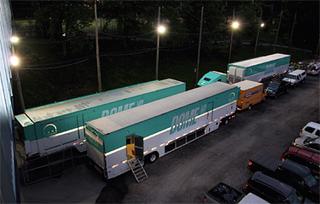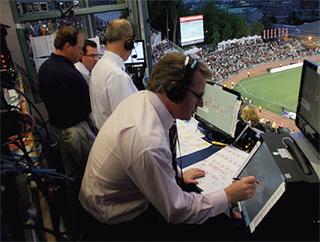CFL Tests Mobile Broadcast Crews
TORONTO — If it's Canadian Football League (CFL) season—and it is—then TSN (The Sports Network) is on the road again. As the CFL's exclusive broadcaster, TSN has to cover 84 games this season. The shoots take place in the CFL cities of Vancouver, Edmonton, Calgary, Regina, Winnipeg, Toronto, Hamilton and Montreal. Given that the driving distance between the furthest two cities—Vancouver and Montreal—is a staggering 3,052 miles, TSN's crews are constantly on the go.

The mobile compound at Montreal’s Molson Stadium "To make life easier, we use teams of mobile HD production units primarily leased from our sister company Dome Productions," said Paul Graham, TSN's executive producer. Dome Productions keeps one set of HD trucks out west to cover games there, and does the rest using trucks from their Toronto headquarters, according to Graham. Production duties are shared between three technical crews, who take turns criss-crossing Canada during the CFL broadcast season (June-November).
Meanwhile, the network's on-air talent spends much of its time in the air between games, flying from city to city.
"Geography is certainly a big challenge when it comes to covering the CFL," says Arnie Wood, Dome's production manager. "With coverage from Vancouver to Montreal and four games every weekend, it requires a dedicated team of Dome employees to ensure that all travel logistics are taken care of. We sometimes have to rely on mobile vendors for assistance. However, through a very detailed and organized planning process by our fleet, scheduling, travel and engineering groups, we have a Dome mobile on site at over 90 percent of all games."
TRAVELING CIRCUS
In many ways, TSN's CFL production team works like a traveling circus: Everything the network needs has to go with them from city to city.
To be precise, "Dome Productions provides TSN with end-to-end technical, crewing and transmission services," said Kryst Budziak, Dome's director of production services. This service includes 53-foot HD production trailers (Dome has seven), equipped with a minimum of 10 cameras (six stationary long lenses and four handhelds) EVS and VTRs for recording/replay; Chyron Duet and Miniboard for graphics, 5.1 audio and intercom facilities; and switching/transmission encoding gear. Dome also handles logistics and hires the technical crew, which totals 29 technicians and engineers per CFL broadcast.

Glen Suitor works the telestrator as Chris Cuthbert discusses the replay with Stats. Canada's eight CFL stadiums have limited broadcast facilities. At best, Dome Productions can count on power and, in some cases, some degree of preinstalled cabling. "Dome has worked with six of the eight stadiums to install a permanent or semi-permanent cable infrastructure," said Wood. "We also rely on local vendors to provide us with various items, from camera carts, lighting and security to fencing for our mobile compounds." Along with its mobile units, Dome Productions has created specific "CFL Kits" that are shipped from city to city. "These kits contain the additional microphones, monitors, telestrators and other outboard equipment required for each broadcast," Wood says.
TECHNICAL IMPROVEMENTS
TSN has made many improvements to its CFL coverage since it began broadcasting some of the games back in 1987. (TSN shared broadcast rights with CBC-TV until 2007, when TSN became the exclusive CFL broadcaster.) Chief among these are the move from analog to HD, and mono audio to 5.1. Most recently, the network has used cablecam overhead cameras to cover the league championship Grey Cup finals. TSN will also install a cablecam to cover the opening of the new BC Place Stadium in Vancouver this fall.
"Beyond HD, the biggest advances have been the addition of 5.1 surround sound, wireless goalpost robotic cameras, and wireless handheld cameras," said Budziak. In fact, all of TSN's CFL content is produced in 5.1, including sideline interviews and highlight packages. Budziak approvingly describes TSN's audio as "the Cadillac version of surround sound."
TSN is now testing "Super Sounds of the Game," where wireless microphones are put on both head coaches, plus the starting and backup quarterbacks. In concert with Dome, the network is also looking into distributing video signals using streaming over IP, trying out new specialty cameras, and speeding up workflow by recording to hard drives instead of VTRs. "Advances are usually a team effort," Budziak says.
For TSN, the CFL season means six months of constant travel and logistical juggling. Ratings-wise, the effort has been worth it. "We're now getting 400,000-500,000 viewers for preseason games," says Paul Graham. "Ten years ago, those numbers would have been phenomenal for the playoffs."
As for the time away from home? "That's our world," Graham quips. "It's not a headache, it's just part of our life and what we do. It's also why Canadians tune to the CFL on TSN, week in and week out."
Get the TV Tech Newsletter
The professional video industry's #1 source for news, trends and product and tech information. Sign up below.
James Careless is an award-winning journalist who has written for TV Technology since the 1990s. He has covered HDTV from the days of the six competing HDTV formats that led to the 1993 Grand Alliance, and onwards through ATSC 3.0 and OTT. He also writes for Radio World, along with other publications in aerospace, defense, public safety, streaming media, plus the amusement park industry for something different.

